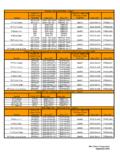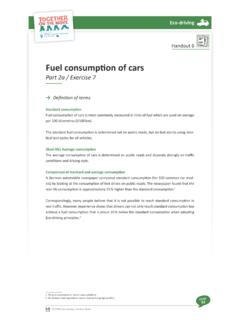Transcription of Drawing together: art, craft and design in schools
1 Drawing together : art, craft and design in schools 2005/08 Executive summary 2 Key findings 3 Recommendations 4 Part A: Art, craft and design in practice 5 Achievement and standards 5 The quality of teaching and learning in art, craft and design 13 The art, craft and design curriculum 20 Leadership and management 25 Part B: Opportunities and challenges in art, craft and design 29 Inclusion and challenge for all 29 Promoting creativity 35 Drawing together the community 40 Notes 45 Further information 46 Annex 1: schools and galleries featured in the case studies of good practice 48 Annex 2: Evaluation criteria 49 Achievement and standards in art, craft and design 49 Teaching and learning in art, craft and design 50 The art, craft and design curriculum 51 Leadership and management in art, craft and design 52 Overall effectiveness in art, craft and design See Further information.
2 This report draws together the findings of subject surveys of art, craft and design education between 2005 and 2008 in 90 primary and 90 secondary schools . These schools were selected randomly to include those in urban and rural areas across England. Inspectors also made 20 further visits to see good practice in schools , art galleries and regional exhibitions of pupils work. Inspectors evaluated pupils achievement and the quality of provision, and assessed the extent to which pupils of all backgrounds and abilities were given the opportunity to succeed in the subject. They considered the possible factors contributing to the wide gap in achievement between boys and girls. The picture was generally a positive one. Pupils art, craft and design work often had a strong and immediate presence in the schools and local communities visited.
3 Even so, at every phase, the quality of provision varied widely. Around half the schools visited used art, craft and design effectively to promote creativity and a cultural entitlement1 for all their pupils. Where art, craft and design were flourishing, schools promoted the subject, valuing its unique contribution to pupils personal development and its impact on their wider achievement. However, in a similar proportion, the curriculum was unimaginative, the range of activities was limited, teaching failed to stimulate creativity and learning was too confined to the classroom. These schools had often failed to challenge ineffective provision in art, craft and design or exploit its contribution to whole-school improvement. High standards were almost always achieved in schools that remained in touch with local or national initiatives and used them to raise expectations.
4 In one half of Foundation Stage settings children s creative development was good, and in primary schools overall one third had consistently good achievement and standards in art and design . Pupils in these schools used sketchbooks regularly, teachers developed pupils responsibility for making choices, and the whole school used display both to celebrate and evaluate achievement. Inspectors met pupils who had experienced their highest achievements and enjoyment through their work in art, craft or design , often stimulated by direct contact with art and artists in and outside of school. In the other two thirds some work was of good quality but standards and provision were too variable. Many pupils had only a limited understanding of the subject and its the secondary schools visited, the best work demonstrated students ingenuity and commitment, as well as the impact of specialist teaching and working with galleries and practising artists.
5 In these schools , there were regular opportunities for and wide-ranging approaches to Drawing . The most original work often resulted from engagement with contemporary practice. The success of these schools was reflected in the good proportion of students continuing on to examination courses, with more choice giving them the opportunity to improve the depth and diversity of their work. Nationally, a high proportion of students who took GCSE and A-level examinations in the subject attained the higher grades. Boys on average continue to achieve considerably less well than girls. Inspectors found that boys achievements rose when they were given opportunities to work for a practical purpose, for example by using digital and three-dimensional (3D) media.
6 However, often they were seen to lose interest and make limited progress where craft and design work was neglected, when they spent too much time writing, and when research was confined to homework. In primary and secondary schools high quality provision and outcomes stemmed from subject leaders who were passionate about the subject and clear about its value, and teachers who inspired their pupils by providing absorbing, challenging and open-ended opportunities for learning which exploited their interest in visual imagery. Poorer provision was associated with weak senior leadership that failed to challenge and question or guide improvement, and inexpert teaching, particularly in the ability to use assessment to encourage creativity or to capture progression.
7 Some secondary schools failed to communicate to parents the relevance of art, craft and design or its relationship to possible careers. The discussion of issues in Part B of this report aims to help teachers build on success in the subject and address concerns emerging from Part A, namely, the contribution of art, craft and design education to pupils inclusion, creativity and community, Drawing on examples from successful schools . Executive summary3 Drawing together : art, craft and design in schoolsn Pupils achievement was good or outstanding in just over half the schools surveyed. The best work seen showed that pupils had the confidence to experiment and draw adventurously. They refined their skills and demonstrated creativity both through their expression of ideas and feelings and in their interpretation of themes and Girls often made more rapid progress than boys.
8 They were more likely to take an art and design course in Key Stage 4 and attained higher grades. Good achievement by boys was associated with a broad art, craft and design curriculum, relevant lessons and the directness of teachers Pupils were inquisitive about the work of different artists, but their limited breadth of knowledge, depth of understanding and range of analytical skills often constrained their ability to draw on such work. Too many pupils relied on secondary sources and remained uncritical about imagery encountered through computer technology. n Just over one third of primary and two thirds of secondary lessons were good or outstanding, with teachers often exploiting the visual appeal of the subject. However, in other lessons, insecure subject knowledge and insufficient differentiation or use of subject-specific assessment restricted the level of challenge and constrained pupils progress and Boys and girls enjoyed practical lessons.
9 Collaborative and expressive work which drew on individual experience or concerns about, for example, global issues accelerated their personal development. Ill-judged written tasks deflated enthusiasm and diminished their sense of Visits to art galleries and work with visiting artists played an important role and often had an immediate impact on pupils aspirations and achievement, but such experiences were rarely available to all pupils. Sustained links, including those with the creative industries, were underdeveloped. n Contemporary art and digital media enriched the curriculum and pupils exploration of abstract concepts. However, in more than half the schools visited, craft and design dimensions were underdeveloped, topics were unimaginative and there was a lack of response to pupils cultural The subject was led with passion and pride in many of the schools visited.
10 However, subject leaders often directed their energy and resources towards celebrating outcomes without the accompanying critical evaluation necessary to improve provision or inform innovation through subject-specific professional development. n In the most effective practice, a school s ethos and environment benefited from art and design , as did its local community. However, insufficient opportunities exist for the wider community to appreciate the achievements of students as young artists, craftworkers and designers, or for schools to learn from others Department for Children, schools and Families and the Department for Culture, Media and Sport (DCMS) should:n promote opportunities for every child and teacher of the subject to have the opportunity to work in an art gallery, or with an artist, craft worker or designer as part of their cultural entitlementn further develop the National Archive of Children s Art, craft and design and consider dedicating a national gallery space to the creative achievements of children and young people in England.
















